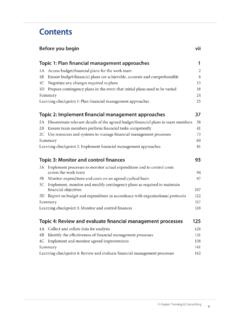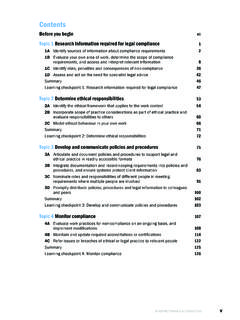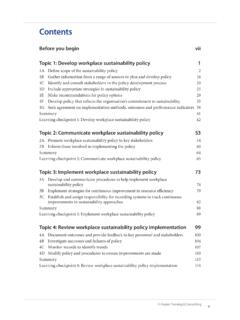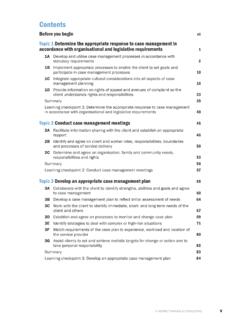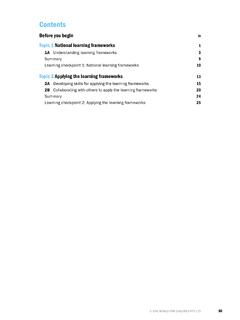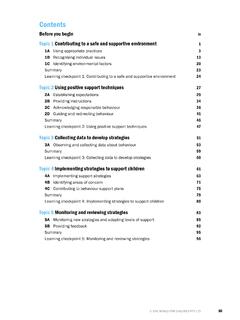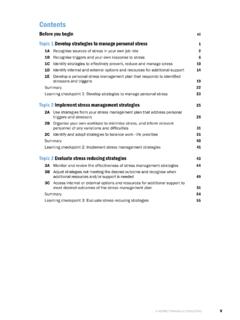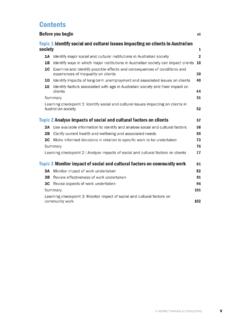Transcription of BSBWOR502 Lead and manage team effectiveness
1 Aspire Training & ConsultingvContentsBefore you begin viiTopic 1: Establish team performance plan 11A Establish a common understanding of team purpose, roles, responsibilities and accountabilities 21B Develop performance plans for the work team 101C Support team members in meeting expected performance outcomes 15 Summary20 Learning checkpoint 1: Establish team performance plan 21 Topic 2: Develop and facilitate team cohesion 272A Develop strategies to ensure team members have input into planning, decision-making and operational aspects of work team 282B Develop policies and procedures to ensure team members take responsibility for own work and assist others to undertake required roles and responsibilities 342C Provide feedback to team members to encourage, value and reward individual and team efforts and contributions 382D Develop processes to ensure that issues, concerns and problems identified by team members are recognised and addressed 43 Summary51 Learning checkpoint 2: Develop and facilitate team cohesion 52 Topic 3.
2 Facilitate teamwork 593A Encourage team members and individuals to participate in team activities 603B Support the team in identifying and resolving work performance problems 653C Serve as a role model for the work team and enhance the organisation s image 69 Summary72 Learning checkpoint 3: Facilitate teamwork 73 Topic 4 : Liaise with stakeholders 794A Establish and maintain open communication processes with all stakeholders 804B Communicate information from line manager/management to the team 834C Communicate unresolved issues, concerns and problems raised by team members and follow up with stakeholders 864D Evaluate and take necessary corrective action regarding unresolved issues, concerns and problems 89 Summary93 Learning checkpoint 4 : Liaise with stakeholders 942 Aspire Training & ConsultingBSBWOR502 Lead and manage team effectivenessIn work teams, having a common purpose and a clear understanding of the roles, responsibilities and individual goals within the team dynamic is essential to ensuring a quality outcome.
3 In this case, quality refers to more than just a positive outcome in relation to the prescribed goals; it also means the cohesion of individuals within the team environment and the lasting impressions of the success (or otherwise) of the group a leader, aligning the focus of the team helps to enable the team members to achieve goals. Important issues to consider include facilitating a shared understanding of: the purpose of the organisation, who its customers are and the team s role with thecustomers what the organisations goals are, and how your team will help achieve required to effectively lead teamsIn order to get the most out of their teams, managers and team leaders should firstly have an understanding of the skills required to lead teams, and what constitutes a skills you require to effectively lead teams include: planning and organising skills training skills communication and consultation skills conflict resolution constitutes a teamIt is important to understand that a group of people does not necessarily make a team.
4 There are a number of critical factors that make a group of people a team, such as the size of the team, appropriate knowledge/skill mix, defined purpose and goals, a common approach and joint accountability. Teams are created for many reasons. The following table is a short list of the various types of teams. Does your team fit one of these categories? Adapted from: Leading teams: expert solutions to everyday challenges 2006, Harvard Business School teamAn organisational group that reports to a single point and may or may not have to work together to meet group teamTeam members from different functions across the organisation whose time is dedicated partially to the team s efforts and partially to other functional Establish a common understanding of team purpose, roles, responsibilities and accountabilities4 Aspire Training & ConsultingBSBWOR502 Lead and manage team effectivenessFeedback and consultation methodsMechanisms such as scheduled meetings, bulletin boards, text messaging, shared computer network spaces, blogs.
5 And even tweets and other social media can be used to provide feedback to the work team in relation to outcomes of any particular process of consultation can be achieved through the methods detailed of consulting with others and getting feedback in the workplaceMeetingsFormal, scheduled meetings and informal, ad hoc gatherings between team members contribute to a better understanding of tasks, responsibilities and rolesInterviewsCreating a list of questions to establish knowledge, skills and understanding of the task can help you identify individual needs and attributesBrainstorming sessionsThe group as a whole considers a number of possible perspectives. Successful brainstorming requires commitment, contribution and cooperation by all team membersEmail/intranet communication If a team is geographically dispersed, a system of electronic communication can aid understanding and contribution by all team members6 Aspire Training & ConsultingBSBWOR502 Lead and manage team effectivenessTeam chartersA team charter documents the purpose, structure, processes and expectations of the group or organisation.
6 A team charter is usually drawn up in negotiation with a team sponsor, team leader and the relevant team members. Team charters should be established when the team is formed or when a team is in trouble and people need to regain their view of the big picture. There is no specific format to a team charter, as they should be created to suit the specific team environment. The following components provide guidelines for you to use when creating a charter for your own The context is the situation and environment in which the team will can include information about the workplace or specifics about the project environment. Mission and objectives The mission and objectives are statements that help you establish what willbe achieved by setting measurable goals and objectives. The mission is an overarching statement covering the project scope; for example; to create a new manufacturing process for the widget division.
7 Following the mission, the objectives should be stated clearly and concisely. Detail of specific goals should be written by ensuring the objectives are numbered and time frames or deadlines are assigned to each. Composition and roles Once your mission and objectives are framed, select team members thatcan contribute to the achievement of these objectives. Consider: selecting individuals with the knowledge, skills and experience needed todo the job selecting individuals from diverse backgrounds and from differentdepartments within the organisation previous experience working together size and location of the framework Once the roles have been assigned, develop the support framework toensure each member has the information, resources and psychological support to begin the work. As part of this process you will ensure the tasks are matched to team member skills and assess any skills and/or knowledge gaps that exist in order to plan for Aspire Training & ConsultingBSBWOR502 Lead and manage team and rolesThe team will consist of: Jemma Ward: Production team supervisor.
8 Tasked to interviewteam members and offer insight into the physical requirements ofthe production process Jim Williams: Plant supervisor. Tasked to provide technicalinformation regarding the production machinery and machineoperators Floyd Stein: Production manager. Tasked to consider financial andcorporate implications of the team s recommendations. Assigned as group leader Bridget Chivers: Production administrator. Tasked to liaise with production staff and arrangetimes, materials and other resources for interviews and training room and supportThe team will need access to the production floor and training room for four days. Other resources include: laptop, printer, photocopier and project in the training room passes and high-visibility safety gear for the production floor observation and interview documentation stationery The team will meet on Monday morning to formally assign roles, and receive their passes andsafety equipment for the production floor.
9 The interviews and observations will take place immediately using the provided proformas. The team will gather together in the training room on day 2 to analyse the data and brainstormrecommendations. Floyd Stein will ensure contingencies are considered. The team must reachagreement on recommendation by the end of day 2. Failure to do so will affect the arrangementsto meet with the senior management team. Bridget Chivers will create the presentation once agreement has been reached. The team will jointly present their recommendations to the senior management team and presentthemselves for questioning after the charter and its contents have been agreed to by:Name: _____Date _____Practice task 1 the methods you would use to consult with your team to establish a clear teampurpose, and well-defined roles and.
10 Aspire Training & Consulting11To p i c 1 Establish team performance planPerformance plansThe first stage of managing an effective team is the planning stage. As a team leader you will be required to administer performance plans for your team members. Performance plans for individuals or teams generally contain: performance measures such as KPIs specific goals to be achieved by each team member, or the entire group the actions required to achieve those goals a schedule outlining how long it should take to achieve each goal the methods that will be used to monitor, evaluate and reward input from stakeholdersIt may seem counter-intuitive to negotiate a KPI, but this process has several benefits. Negotiation can highlight the strengths and weaknesses of individual employees or the team as a whole. As a manager, you can allocate the right work to the right team member based on the outcomes of this process.
